
The riveting, spellbinding new documentary My Old School is now playing in select theaters and will continue to expand to more locations throughout the summer. Director Jono McLeod interviews a group of people who were classmates and friends of Brandon Lee in a Scotland high school in the ’90s. Lee is also interviewed for the film but didn’t want to be shown on camera, so Alan Cumming appears in a classroom and lip-syncs Lee’s audio.
Lee has had an unconventional impact on many lives, and My Old School uses animation as visual aid for the stories we hear and information we learn. Animation Director Rory Lowe gives me a crash course in the making of one of 2022’s best movies. (This spoiler-free interview is edited for length and clarity.)
Jackson Murphy: When did you first hear the Brandon Lee story, and what were your initial reactions to it?
Rory Lowe: I’m in the same school year as [director] Jono [McLeod] but on the other side of the country. I remember hearing it on the news when we were in school and I was like, “Wow. What was that all about?” Finding out the details of it and what actually happened and hearing the details from Jono’s perspective and from the interviews he’s done… it’s mind-blowing. It’s absolutely mind-blowing.
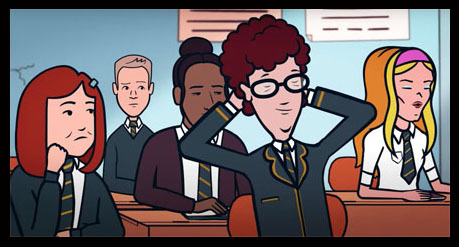
JM: It is! The animation is such a core part of it. And you’re right about details. What was your approach when it came to the overall attention to detail that you wanted to give with the animation?
RL: There was a real feeling of “we need to get it right for the people in the [movie].” These are real lives. These are real people that this happened to. That’s the difference with documentary vs. narrative storytelling in animation. You suddenly feel like you’ve got a different responsibility. And there’s a whole thing with nostalgia. From an audience perspective you’re finding out this incredible story. But it’s also reminding you of what it was like to be at school. There’s loads of universal experiences that everyone’s been through… and types of characters at school and how it plays out. That was the detail.
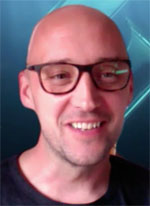
Rory Lowe
JM: It brought me back to some memories. There are so many fascinating perspectives we get. Did you need approval to do the animated versions of these specific people? Did they have any requests?
RL: (laughs) Well there’s always a danger, isn’t it, giving someone too much control on how they’re represented in any form in film? Jono was the gatekeeper of that. Loads of these people are people he knows well — either close friends from school or people that he reconnected with. We had their yearbook from their school, so we had what they actually looked like at the time. And that was our main point of reference. Obviously we had the interviews with them as well, so we’re picking up on their personality traits. It’s my favorite thing in the film, I think, how much you fall in love with the characters, who are these real people.
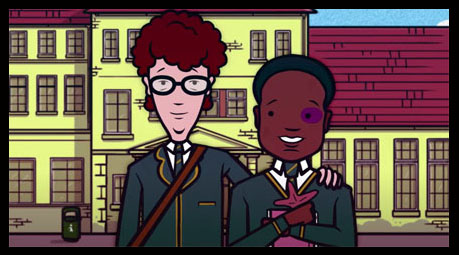
JM: What were your goals with the attitude and the look of the animated Brandon? He has a certain swagger.
RL: It’s a confidence, isn’t it? That’s what’s quite difficult to get with Brandon — that right balance… he’s a villain but he’s not a villain. It’s going on his journey and understanding him from his perspective as well as the influence he had on all the students around him when he’s going through it. There’s an actual swagger. And just being really careful about what his mentality was — why did he do this and what did he want out of it? He had very specific aims and objectives when he did it.
JM: Yes he did! And some of them are absolutely shocking. And one of the other brilliant things about this movie is: you get all this information in the first half — and it’s fascinating. And then the movie completely flips the script and says, “Wait a second, THIS is what actually happened.” You animated one version of some sequences and then you animated a second version. How was it keeping track of all of that?
RL: Keeping track of the animation was, in general, quite a challenge. It’s slightly different from creating a narrative animation where you’ve got really locked-down storyboards. You know what’s working before you’re animating everything. Obviously we’re still attempting to do that in this version of it but it evolves. Documentary evolves in a different way because you find the story through editing and piecing it together. It’s about memories and how you remember things — and gossip and hearsay. How your perception of what happened at the time differs quite largely, in general, from the reality of the objective version of what happened.
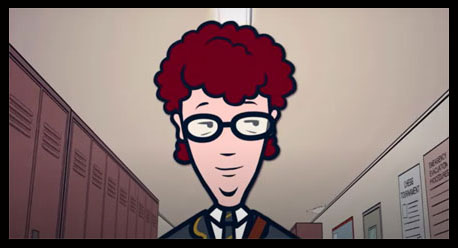
JM: This film seems to be almost 50/50, balancing the live-action and animation.
RL: Making the [animation] feel integrated right from the start and leading you into it seemed like a really key fundamental to the story from the beginning. There are so many layers to it, and you’re hearing the real Brandon but not seeing him. That’s lip-synced. We did also explore an animated [adult, contemporary] version of him, but in the end we thought… because he’s voiced by Alan Cumming in the animation… there’s loads of layers to how that plays out. It introduces you to that and holds your hand into the story. You know exactly where you are, basically, by the time the [opening] credits roll.
JM: You get used to Alan Cumming doing the lip-syncing very quickly. It does not take long. I’m sure a one of a kind experience for an actor who’s been around a long time and has done quite a lot.
RL: Yeah. One of the most experienced actors out there. He makes it look easy, but that’s a combination of the shooting and the editing, and he’s very talented and incredibly skillful at it. We shot three different times and three different directions so it could be really subtly be pasted together — and then finding bits of that that work over the animation and then layered with the reconstructed animation. Alan’s a fantastic actor and an absolute joy to work with. And a lot of fun.
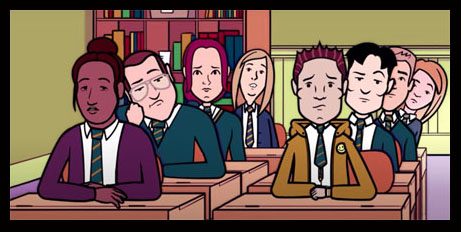
JM: Good. Flee was a game-changer when it came to animation and documentaries coming together. We’ve had some animation in some other documentaries over the years, and I really hope people see My Old School and that this is also a game-changer. How do you feel animation and documentaries coming together is changing these genres?
RL: It’s a growing genre in a way, isn’t it? And this shows that it doesn’t have to just be heavy subject matter that would be impossible to film. You can go lots of different ways. People are starting to explore this in a whole different way and see the possibilities.
JM: I hope it continues to grow. What would you want to animate from your high school days? A wild / crazy event?
RL: What springs to mind instantly is a middle school dance competition with a friend dancing to Footloose, which I don’t think I’ve managed to live-up to the rest of my life, from about age 12, I think. I reckon that would make a good animated sequence — far exceeding reality. That would be great.
JM: Wow. So you did really well it seems like.
RL: Yeah. Well it stuck with me to this point so it must be good. Again, what it’s like in my head compared to what it’s actually like is probably an entirely different thing.
JM: (laugh) I got so immersed in this saga. From your experience making this movie… how immersed did you get? Has it changed your perspective of life, memories, storytelling? How deep did you get into this?
RL: I agree. It so grabs you. It really sucks you in. And it’s quite gentle about the way it does that. And it comes back to the nostalgia thing: you’re remembering your own school days and then getting deeper and deeper into this story. And the characters… you’re talking about real people but they almost seem fantastical and larger than life. We were working on it for about two years. We worked through a whole series of edits and styles. It’s been a long journey but massively captivating at every point and really fascinating to see how it has developed.
- INTERVIEW: Jeff Fowler On “Knuckles” And “Sonic 3” - April 22, 2024
- INTERVIEW: “Inside Out 2” Director And Producer On Pixar Sequel - April 16, 2024
- INTERVIEW: “Puffin Rock And The New Friends” And 25 Years Of Cartoon Saloon - April 10, 2024


 July 26th, 2022
July 26th, 2022  Jackson Murphy
Jackson Murphy  Posted in
Posted in  Tags:
Tags: 






